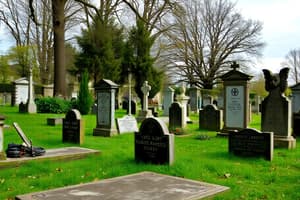Podcast
Questions and Answers
Why is 'Elegy Written in a Country Churchyard' considered a forerunner of Romantic poetry?
Why is 'Elegy Written in a Country Churchyard' considered a forerunner of Romantic poetry?
The poet expresses personal emotion.
Which of the following statements about the 'elegy' is not correct?
Which of the following statements about the 'elegy' is not correct?
- The language is reflective and personal.
- The speaker tries to conceal his own moods and feelings. (correct)
- The speaker reveals his own moods and feelings.
- The work addresses universal themes.
What is the subject of the 'Elegy'?
What is the subject of the 'Elegy'?
- Nature and landscape
- The poet's own experiences
- Famous historical figures
- Obscure, unknown people in a churchyard. (correct)
What does the poet foresee in the 'Elegy'?
What does the poet foresee in the 'Elegy'?
The 'Elegy' contains instances of all of the following except:
The 'Elegy' contains instances of all of the following except:
What is the basic purpose of lines 1-16 in the 'Elegy'?
What is the basic purpose of lines 1-16 in the 'Elegy'?
What do lines 17-32 do in the 'Elegy'?
What do lines 17-32 do in the 'Elegy'?
What do lines 33-36 imply?
What do lines 33-36 imply?
What do lines 45-60 explore in the 'Elegy'?
What do lines 45-60 explore in the 'Elegy'?
What is conveyed in lines 117-128?
What is conveyed in lines 117-128?
Flashcards are hidden until you start studying
Study Notes
Thomas Gray's "Elegy Written in a Country Churchyard"
- Considered a forerunner of Romantic poetry emphasizing personal emotions.
- The poet’s mood and feelings are transparent rather than concealed.
- Focuses on the lives of obscure, unknown individuals resting in a churchyard.
Themes and Perspectives
- Includes a forward-looking perspective; the poet envisions someone reading his epitaph.
- Lines 1-16 establish a reflective scene and somber mood of the environment.
- Lines 17-32 depict imaginative reconstructions of the lives of the deceased.
- Lines 33-36 express the inevitability of death for all individuals.
Imagining Lives and Circumstances
- Lines 45-60 speculate on what the dead could have achieved under different circumstances.
- Lines 117-128 present the poet's own epitaph, highlighting personal legacy and reflection.
Poetic Structure
- The "Elegy" is notable for its rich imagery and melancholic tone without using inversion as a stylistic device.
Studying That Suits You
Use AI to generate personalized quizzes and flashcards to suit your learning preferences.




